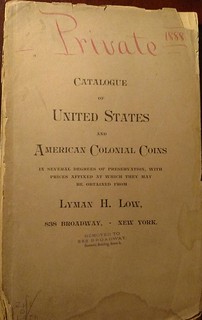
PREV ARTICLE
NEXT ARTICLE
FULL ISSUE
PREV FULL ISSUE
WAYNE'S NUMISMATIC DIARY: NOVEMBER 20, 2016The evening of Tuesday November 15, 2016 I made my way to J. Gilbert's in Mclean, VA for the monthly meeting of my numismatic social group, Nummis Nova. Our reservation was for 6:45, but I arrived around 6. Waiting in the lobby was Eric Schena. I checked my phone to find a text from my guest for the evening. Len Augsburger was in town doing some work for the Newman Numismatic Portal at the Smithsonian National Numismatic Collection. He was at a table in the crowded bar, and Eric and I made our way over to him and sat down. Soon we were joined by fellow early birds Lenny Goldberg and Wayne Herndon. I introduced Len to Lenny. He already knew Eric and Wayne. He told us about the Smithsonian work as we ordered drinks. I forget what prompted it, but I mentioned my visit to a vinyl record shop when I was in St. Louis recently. That led to a discussion of favorite music and Eric told us he'd been a radio DJ for three years in college. I told him, "Gee, you're cooler than we thought!" When he told us it was a heavy metal show, I said, "OK, you're WAY cooler than we thought." Eric had some good stories about getting passes to concerts and phone calls from listeners in the county jail. He was glad to play their requests. Before long our table was ready and we moved to a small room just off the main dining room. I ended up seated across from Len, next to Steve Bishop. Between me and Len were Wayne Herndon and Roger Burdette. Other attendees included Robert Hoppensteadt, Mike Packard, Julian Leidman, Joe Esposito, Dave Schenkman and Joe Levine. Conversation naturally turned to the recent election and a discussion of the Electoral College. Generally, we like it and felt it served the purpose the founders intended. Other topics included famous people we'd met. Joe Levine knew Donald Trump's older brother Fred. Another time at a reception Jimmy Hayes said to Joe, "I want you to meet my friend Tony." The two talked for a good while, but it wasn't until later Joe realized he'd been speaking with Supreme Court Justice Anthony Kennedy. Overstruck Russian Coppers Copper Coins of Catherine the Great (1762-96) Struck Over Coins of 1762 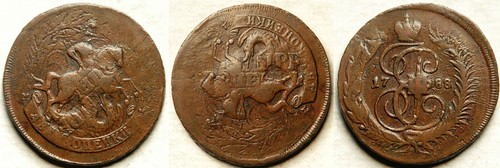 1788 MM 2 Kopeks struck over 1762 4 Kopecks 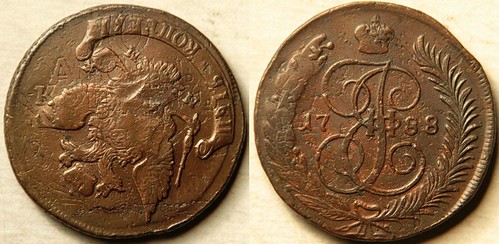 1788 MM 5 Kopecks struck over 1762 10 kopecks Steve writes: The two coins that instigated my conversation with Wayne are pictured above. The question that Wayne asked about these two pieces was logical. How did I know that these coins were struck over the coins that I claimed they were, since he could not see any trace of the date 1762 in the undertype? It is a truism in overstrike collecting that the exact date of the undertype is not identifiable in many cases because the overstrike obliterates the old date. Thus, it is often the case that only the general type and a date range are identifiable. In this case, I know that the coins were struck over 1762 coins for two reasons. First, this particular date and mint combination are very commonly found struck over 1762 coins. The 1762 coins were overstruck by Catherine the Great because Peter III, who ruled briefly in 1762, had changed the monetary standard so that the value of the copper coins were doubled by halving the amount of copper. That is, the value of one ruble of copper was deemed now to be worth two rubles. One kopeck became two kopecks, two kopecks became four, etc. Catherine changed the monetary standard back to what it had been previously. Although two kopeck and five kopeck pieces of Catherine are sometimes found struck over two and five kopecks of Elizabeth, most of them were struck over the 1762 issue to prevent coins of the same weight but different denominations from circulating concurrently. This is the primary reason that the copper coins of Peter are so scarce. Secondly, Peter's coins had a distinctive design, so by seeing the traces of his designs on an overstruck piece, no signs of the date are necessary to identify the date of the undertype, since his coins were struck only in 1762. Pennsylvania Slate Company Note 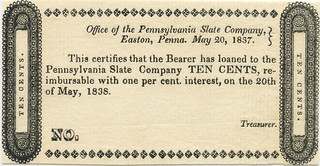 The first item I saw passed around the table was this neat interest-bearing scrip note from the Pennsylvania Slate Company in Easton, PA brought by Dave Schenkman. Dave only knows of two other slate companies that issued notes. QUICK QUIZ: 1% interest on ten cents from 1837 til now = ? Earliest Token Dies 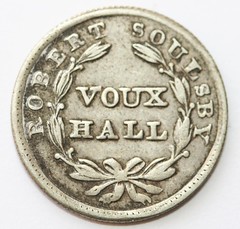 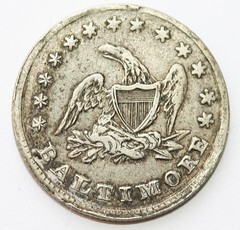 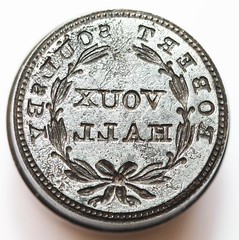 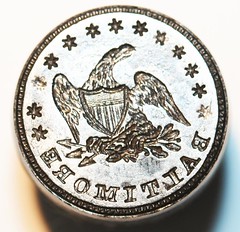 Dave writes: Rulau lists the token as MD 159. He gives the dates of issue as 1845-6, but Soulsby was owner of the Vaux Hall Tavern (or Garden, as it was often referred to) as early as 1838. These dies surfaced in a Baltimore flea market many years ago, and I was able to purchase them. To the best of my knowledge it is the earliest known set of token dies. Covered Bridges and Tokens in Virginia 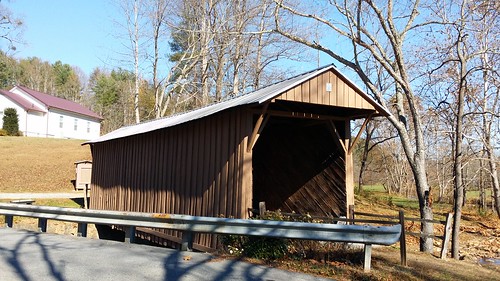 Jack's Creek bridge in 2016 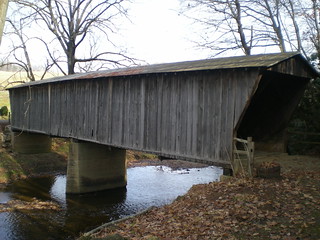 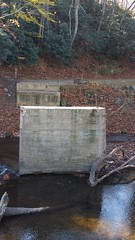 Bob White bridge in 2012; remains in 2016 Our room was cramped and our table long, so I didn't get to speak much to the folks at the other end. Eric Schena provides this report: I had some neat discussions down my end of the table with Dave, both of the Joes, Julian, and Mike. Lots of token talk (natch :-)) but did a little discussingof the Stack's Bowers auctions at Baltimore, neat colonial coppers, the changing colors of the leaves, plus the covered bridges of Patrick County, Virginia. The previous weekend, I went down to Martinsville to help at my wife Heather's family's homestead and on my way back, it was a clear fall day so I decided to take a somewhat more scenic route to I-81 than the usual road. I went through Bassett, Woolwine, Floyd, Riner, and ended up at Christiansburg. The scenery was excellent since the leaves were just past peak (but not too much) and that afforded me to stop and take pics of the covered bridges in Woolwine. Until last year, there were two covered bridges in the county (and eight in the state), the Bob White Covered Bridge and Jack's Creek Covered Bridge, but that changed when a sudden flood in 2015 washed the Bob White completely away. I took pictures of the bridge a couple years prior so I have before and after shots now. I also took a bunch of pics of Jack's Creek in case that, too, disappears. In case you are curious, the nearest covered bridge to the DC area is the Meem's Bottom Covered Bridge outside of Mt. Jackson in Shenandoah County. Not only can you get to it easily off of Rt. 11 but you can drive over it (which I have done). It is sudden events like what happened to the Bob White bridge that keep my desire to photograph these vernacular and often ephemeral structures (like general stores and rural banks) before they are all gone. That happened to a general store I photographed for Dave Schenkman's Virginia token book: a decaying store in Rileyville was eventually torn down and now is a church parking lot. As far as I know, the last published photo of that store is now in Dave's book. Eric's bridge photos reminded me of a picture I took last Sunday afternoon. Middle son Tyler is learning to drive and he let me pick our destination. I wanted to drive to the Potomac river. He thought it was very far away, but the truth is, like many towns our area had turned its back on the river. It's hidden behind businesses and housing developments and you'd never know it was there without a map. But ten minutes later we pulled into a nearby park, got out of the car and walked toward the river, passing through part of a golf course on the way. This stretch of the river has no bridges for many miles, and looks quite natural, like it might have looked hundreds of years ago before settlers arrived here. We walked out on a peat bog to some rocks and looked around for a while. Tyler took some pictures, too. Here's mine: 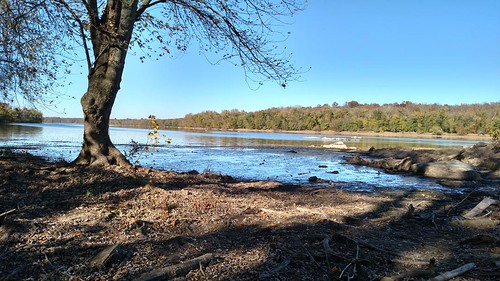 Eric continues: I did not have much of anything to bring of note, except maybe one piece in keeping with the unintended Patrick County theme: a very rare token issued by W. H. Wimbish of Stuart, VA. It's in miserable (dug) condition, but is one of only two known specimens from that merchant. The gentleman from whom I got the piece found it in a lot that was apparently adjacent to Wimbish's original home in Stuart. He ran a general store there until his death of typhoid fever in 1914. The condition may make a few folks wince, but that does not bother me one bit. It's a very rare token with some neat history behind it from a pretty part of the state. I've made a bit of a specialty of finding tokens from that county - I am now on the lookout for tokens from Stella and Woolwine. 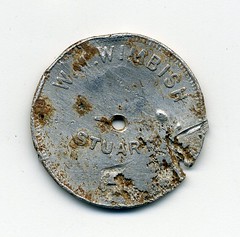 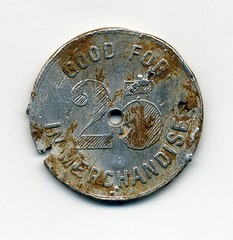 W. H. Wimbish token Len Augsburger Visits Homren Numismatic Library My route swung past the U.S. Capitol building, with its bright spiffy renovated dome, then past some of the Smithsonian Museums. On a crowded streetcorner I yelled over to Len, and he crossed the street and got in. There was a lot of rush hour traffic and we crawled. But it gave us time to catch up on the week's events and plan some upcoming efforts for the Newman Numismatic Portal.
Once in the house we went straight into my office and library. Len was curious about the long row of binders. It's my ephemera collection. I
pulled out a copy of the key and we began pulling down binders to look through. Topics included The U.S. Mint, Proposed Coinage, U.S. Copper Coins,
Correspondence, Colonial Coins, Numismatic Americana, etc. I've accumulated a lot of rare and interesting items over the years. 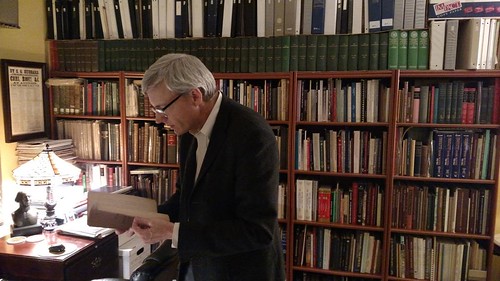 Len Augsburger in the Homren Numismatic Library 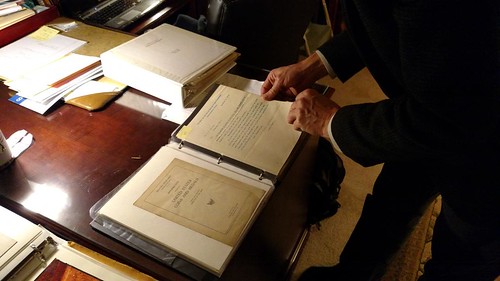 Viewing the Homren Numismatic Ephemera Files It was a fun evening; I rarely get to share my library with visitors who really appreciate the rarity and value of this material. Len signed my guest book. The house was really quiet when our dog Max wasn't yapping at Len. Outside I found out why - Dee and Tyler were across the street at our neighbor's house, where he and his wife had a nice bonfire going in the driveway. Len and I grabbed chairs and beverages and joined them for a while. Later I drove Len back to his rental unit and got another great look at the monuments of Washington D.C., all lit up. Back home I put some books back on the shelves. It was another great week of numismatic fellowship. THE BOOK BAZARREWayne Homren, Editor The Numismatic Bibliomania Society is a non-profit organization promoting numismatic literature. See our web site at coinbooks.org. To submit items for publication in The E-Sylum, write to the Editor at this address: whomren@gmail.com To subscribe go to: https://my.binhost.com/lists/listinfo/esylum All Rights Reserved. NBS Home Page Contact the NBS webmaster 
|
